Terms
- Acculturation: cultural change; the result of the culture of birth and new culture interacting (Kelly, 2016).
- Phenomenology: theoretical framework/approach to inquiry; centers around the investigation of lived experiences (Robbins, Chatterjee, & Canda, 2011).
- Transitioning: a process; moving from one status to another (Blackburn, 2016; Kelly, 2016).
- Abbreviations: military-to-civilian transitioning (MCT); migrant transitioning (MT; from living in one’s country of birth to living in the new country)
- Veteran Migrants (VMs): former service members who stay in the country they served, which is different from their country of origin (Chishti, Rose, & Yale-Loehr, 2019).
Discussing terms and abbreviations.

Significance: Attempts to Determine the Numbers of Latino VMs
For the chosen topic, discussing the problem is rather difficult because its scope is almost impossible to determine. Indeed, the number of VMs cannot be stated because it seems that there is no official information about them. The number of non-native-born American military members was estimated at around 3% of the Army in 2019 (“Total available active military manpower,” 2019). In 2016, the US Department of Veterans Affairs (n.d.) reported that in Hawaii, as well as the US, roughly 7% of the military members were Hispanic. It can be suggested that 3% of those could be Latino VMs, which would make the number 254 for Hawaii and slightly over 44,000 for the US.
However, this supposition requires multiple assumptions. For example, one has to assume that the 3% observation applies to all groups within the military, even though minority service members might be more likely to be non-native-born than white service members. Similarly, one has to assume that the 3% number also applies equally to all states, including Hawaii. Moreover, 3% is the number for non-native-born active members who were operating in 2019, but the veteran statistics refer to the veterans who may have been released years ago when this number did not apply. Finally, the data are only available for Hispanics, not Latinos. However, in the absence of more specific data, these estimations will have to be used. They show that the number of VMs, especially Latino VMs, is probably not very large when viewed from the perspective of the US population, but it is still likely to amount to thousands of people in the US and hundreds in individual states.
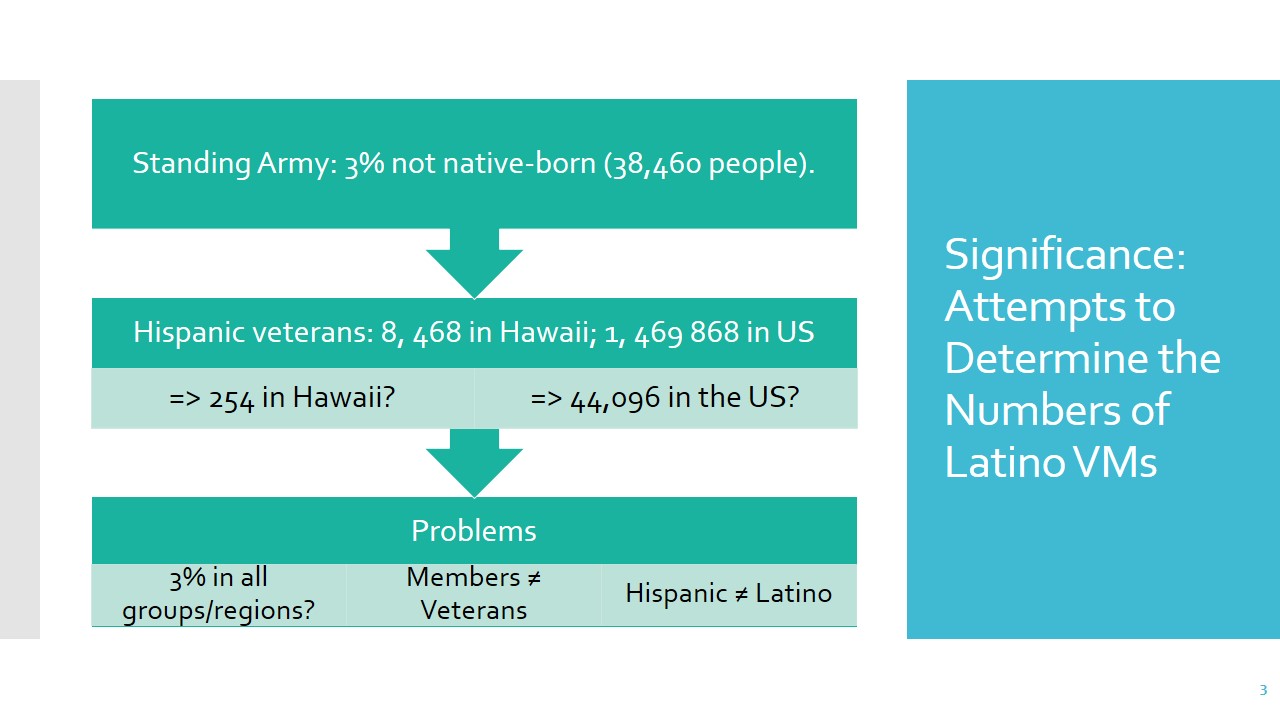
Significance and Scientific Premise
- Veterans and migrants: vulnerable populations; difficult transitioning:
- Problems acquiring housing, jobs, and healthcare (US Department of Veterans Affairs [DVA], 2018; Organization for Security and Co-operation in Europe [OSCE], 2018).
- Acculturation (Blackburn, 2016; Kelly, 2016).
- VM: double transition (MCT, MT) and interactions between MCT and MT:
- Example: MT is associated with socialization deficit (Benton & Embiricos, 2019); socialization facilitates MCT (Hachey, Sudom, Sweet, MacLean, & VanTil, 2016).
Furthermore, the fact that veterans and migrants go through difficult transition processes is well-supported by research literature and government or supra-government reports. Both veterans and migrants are minority populations and have difficulties with acquiring good jobs and education, finding appropriate housing options, and receiving healthcare. Also, both these groups experience an acculturation process since the military has a culture (Blackburn, 2016; Kelly, 2016). There are more specific problems as well; for instance, native veterans generally do not have to learn a new language, but migrants often do. However, when VMs are concerned, the challenges that apply to both populations become relevant. They may even interact; for example, as a result of cultural and linguistic barriers, migrants are reported to have problems with integrating into a new community (Benton & Embiricos, 2019), but communal support is critical for veterans’ re-integration (Hachey et al., 2016). As a result, VMs may experience unique and more challenging situations than migrants or veterans. While researching VM experiences would help to understand the needs of veterans and migrants, their investigation is valuable on their own, especially for social workers who are involved in programs for VMs.

Scientific Premise: Current State of Knowledge (Research Gap)
- Leal and Teigen (2018): voting among veterans, including Latino.
- Horyniak, Bojorquez, Armenta, and Davidson (2017): VM deportation and its effect on their health; not focused on Latinos.
- Atuel, Hollander, and Castro (2018): minority service members and their reasons for joining the military. Not veterans, but Latinos included.
- Wong (2017): migrants and nervous attacks. Pros: focuses on Latinos and the impact of cultural factors on one’s health. Cons: barely mentions the military (but recognizes it as a factor); not peer-reviewed.
There are studies about veterans and migrants (both qualitative and quantitative), but the literature on VMs, especially Latinos, is nonexistent. During this project, one article that considered Latino veterans’ voting habits was found (Leal & Teigen, 2018), and another one reflected the deportation of VMs, even though it did not focus on Latinos (Horyniak et al., 2017). Also, an article about the reasons for various minorities, including Latinos, to join the military was encountered (Atuel et al., 2018). There may be non-peer-reviewed sources as well; for example, Wong (2017) wrote a dissertation about the impact of culture on one’s health, and it is focused on Latino migrants. However, it barely mentioned military service, even though it is acknowledged as a factor in mental health. Overall, however, there are no studies that would consider VMs and their transitions, which means that more research is necessary.
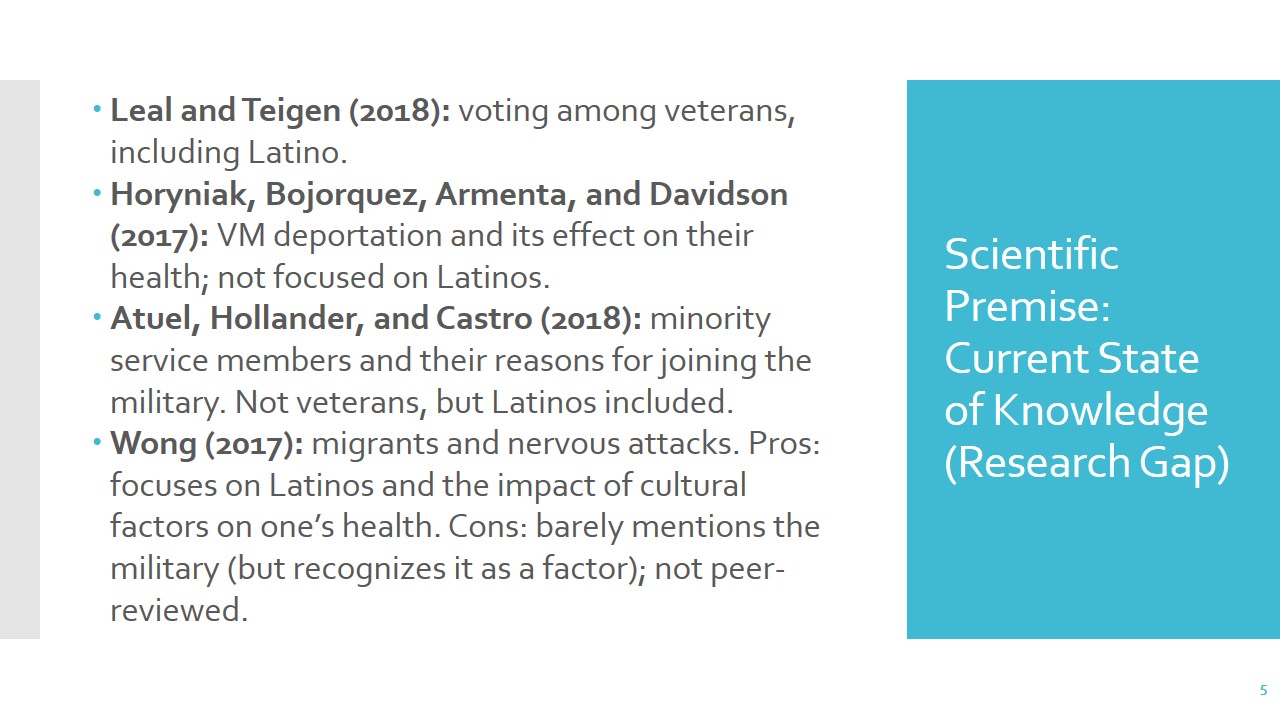
Research Question
What are the lived experiences of first-generation Latino service members who decided to remain in the US after transitioning?
To cover the gap, the presented research question is proposed. It demonstrates the future project’s focus, key terms, and the general approach to investigation, which is clearly qualitative.
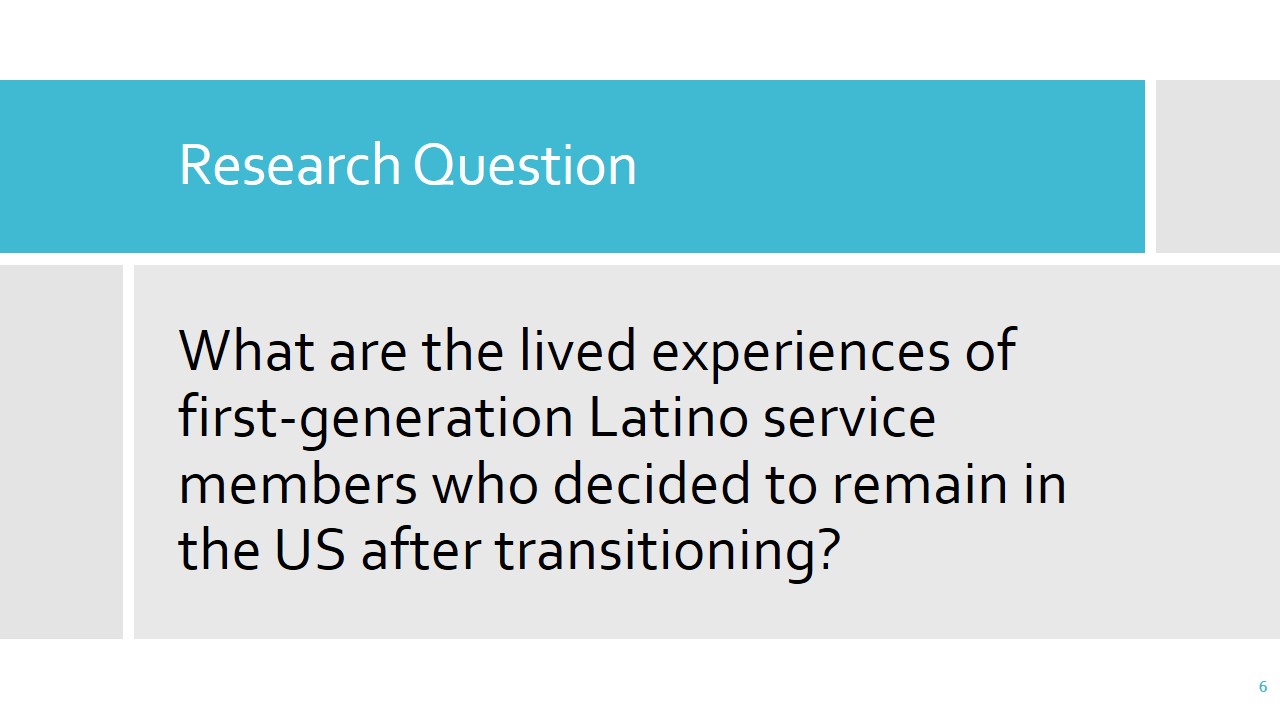
Paradigm, Approach, and Theory
- Interpretivism;
- Phenomenology;
- Military Transition Model and Multidimensional Model of Bicultural Identity;
- Also: OSCE (2018) and DVA (2018).
Indeed, the proposed project will consider experiences, which means that it can benefit from taking the form of a phenomenological study. In line with that, an interpretivist paradigm was chosen due to its interest in subjectivity, experiences, and their role in research; the paradigm of interpretivism and the approach of phenomenology support each other (Mayan, 2009). As for the specific model used to guide the project, it incorporates the ideas of the Military Transition Model (MTM) by Blackburn (2016) and those of the multidimensional model of bicultural identity (MMBI), which is described by Robbins et al. (2011). The two models were augmented with the help of the transition and integration criteria put forward by OSCE (2018) for migrants and DVA (2018) for veterans.
The final model is presented here. It uses MMBI’s multiple dimensions (especially time), MTM’s focus on the factors that affect people before, during, and after release from service, and the specific integration factors from the reports by DVA (2018) and OSCE (2018), including internal, economic, and sociopolitical ones.
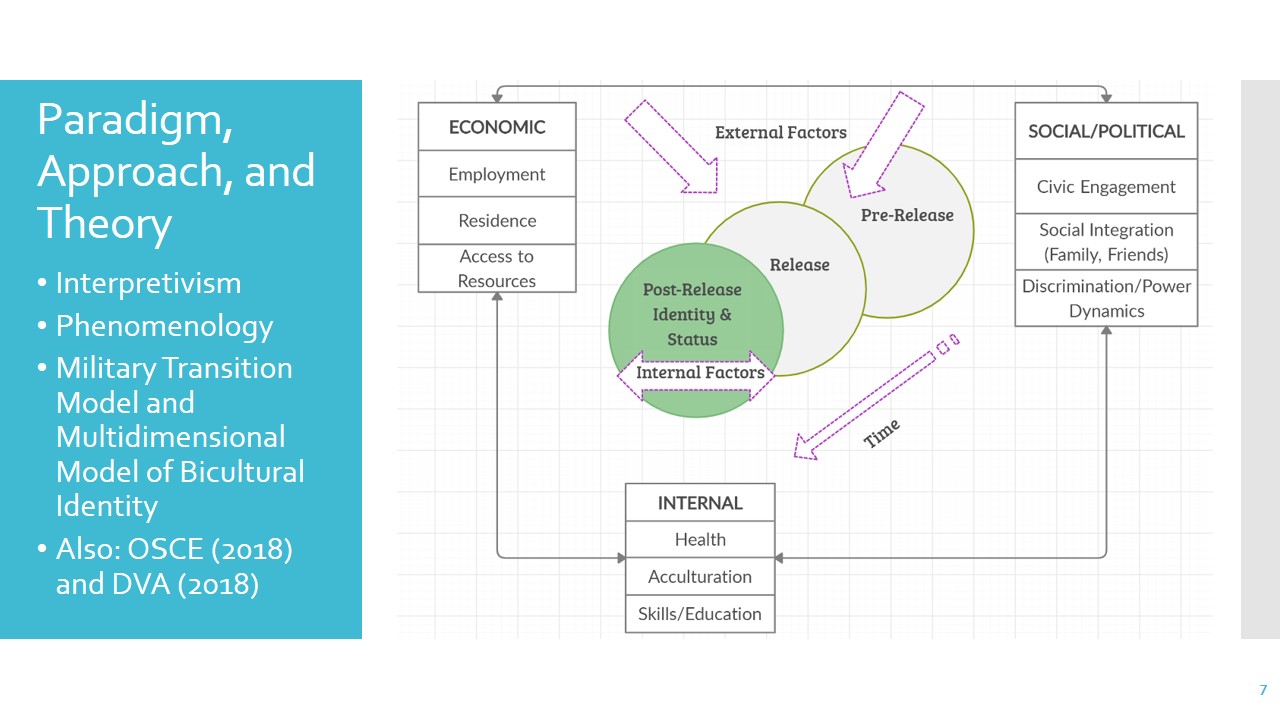
Methods: Sample, Measures, Analysis
- Data collection: semi-structured interviews; audio-recorded and individual. Quantitative demographics.
- Self-developed model-based tool (will be tested): barriers, facilitators, other factors, transition features, acculturation, outcomes, satisfaction.
- Sample: purposive/snowball (data saturation); veteran centers/other; included: Latino VMs; excluded: mental capacity concerns.
- Analysis: continuous, iterative, inductive thematic analysis with NVivo (Tolley, Ulin, Mack, Robinson, & Succop, 2016).
As it was mentioned, veterans and migrants are often researched qualitatively, and it is the only approach suitable for a project which intends to investigate experiences. Interviews are a good idea due to their ability to provide insights into human experiences (Gray, Grove, & Sutherland, 2016). The interview tool for this project is self-developed, and it consists of the questions about the different factors identified by the model. For example, it inquires about barriers, facilitators, changes over time, and acculturation. The interviews will be face-to-face, semi-structured, and audio-recorded; the time and location will be up to the participants. The quantitative data will be gathered to describe the participants; it will include factors like age, time spent in the military and the US, and English proficiency.
Purposive sampling will allow recruiting up to 10 Latino VMs from the military centers of Hawaii. Additionally, snowballing will be used to involve veterans who do not visit centers. The sample will be stratified to include the people who are satisfied with their transitioning and those who are not. Inclusion criteria consist of the participants being Latino VMs; people who are susceptible to coercion (in particular, those with diminished mental capacity) will be excluded.
A percentage-based summary of demographics will be offered, and an inductive thematic analysis will be applied to the transcripts of the interviews. The advice by Tolley et al. (2016) will guide the process, and NVivo will make it easier.
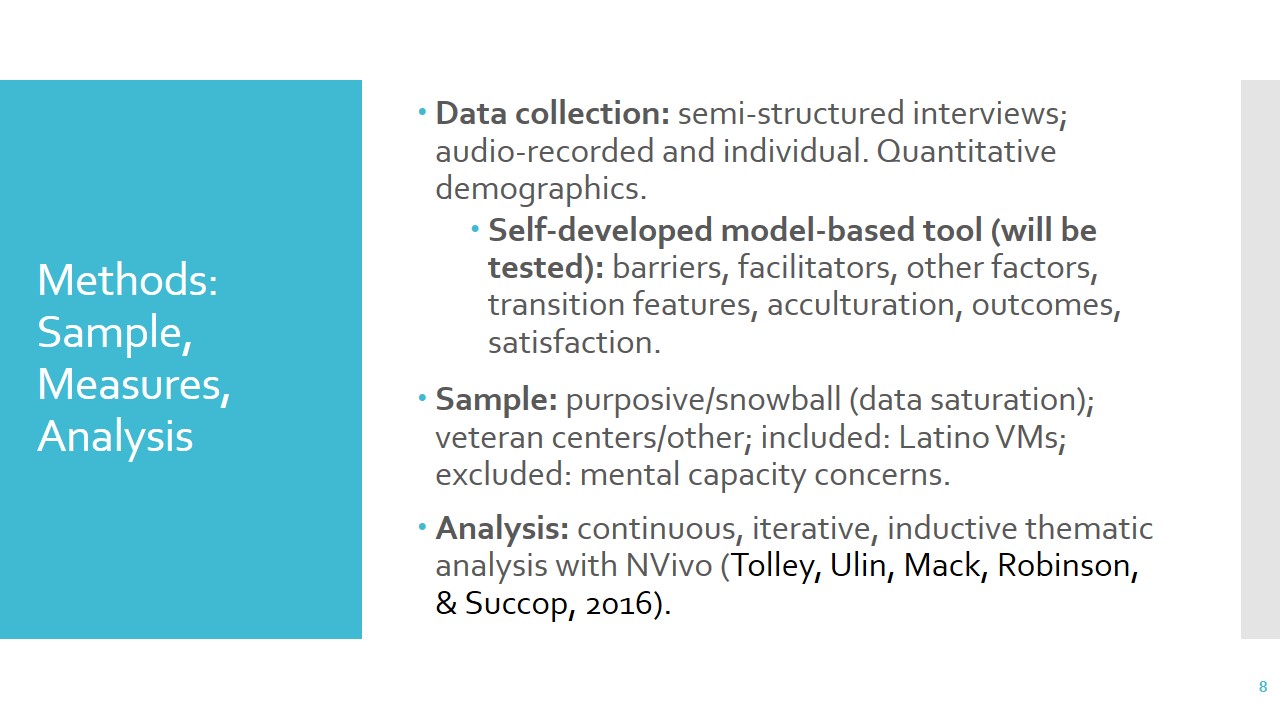
Methods: Timeline
The project will not take too long, and it will be self-funded with barely any costs other than participant compensation gift cards ($50 each). The project will undergo the stages of proposal, research, and findings reporting. The research step will consist of overlapping activities: recruitment will be going on together with interviews and analysis to ensure data saturation.
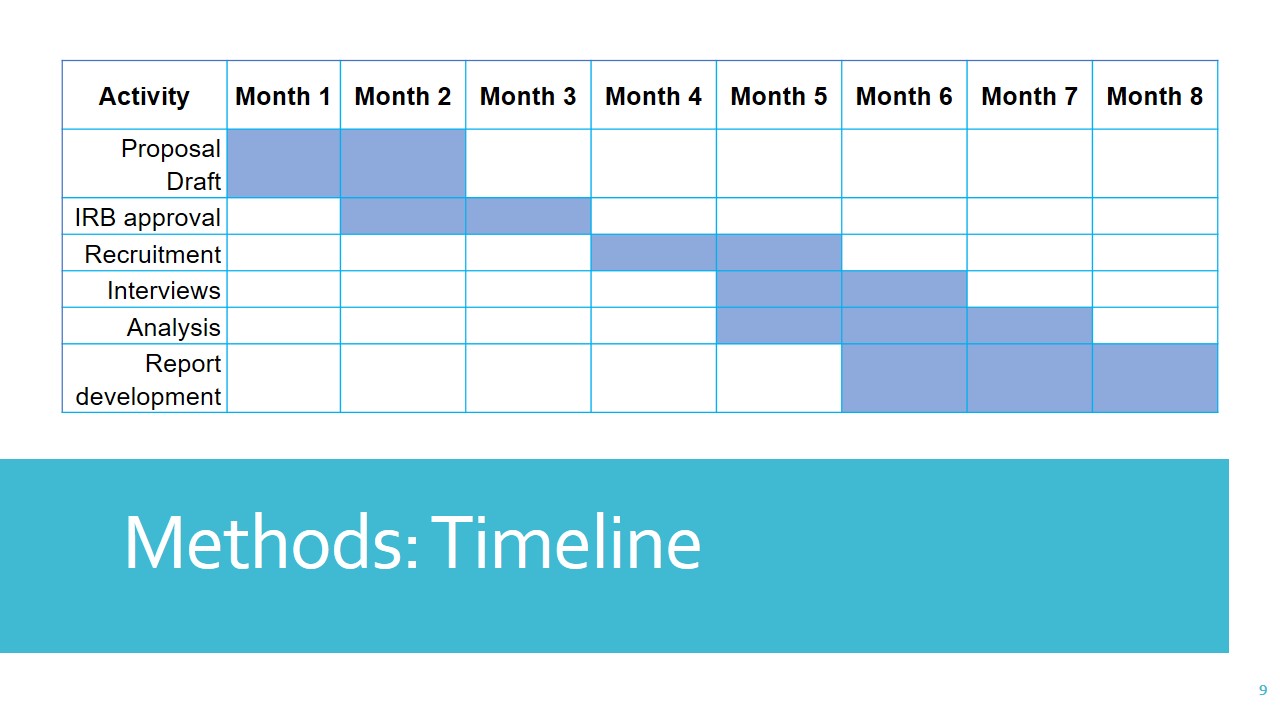
Methods: Rigor
From the perspective of rigor, all the four rigor elements have been considered. First, this proposal shows that the methodology is coherent, and the intent to achieve data saturation is an element of the sampling strategy. Second, I am not the only person who will be involved in analysis; my team will consist of two more researchers, and the participants will be engaged in reviewing findings. Finally, I will keep a journal to reflect my biases, and I will disclose all of them, as well as the project’s limitations, while reporting the results.
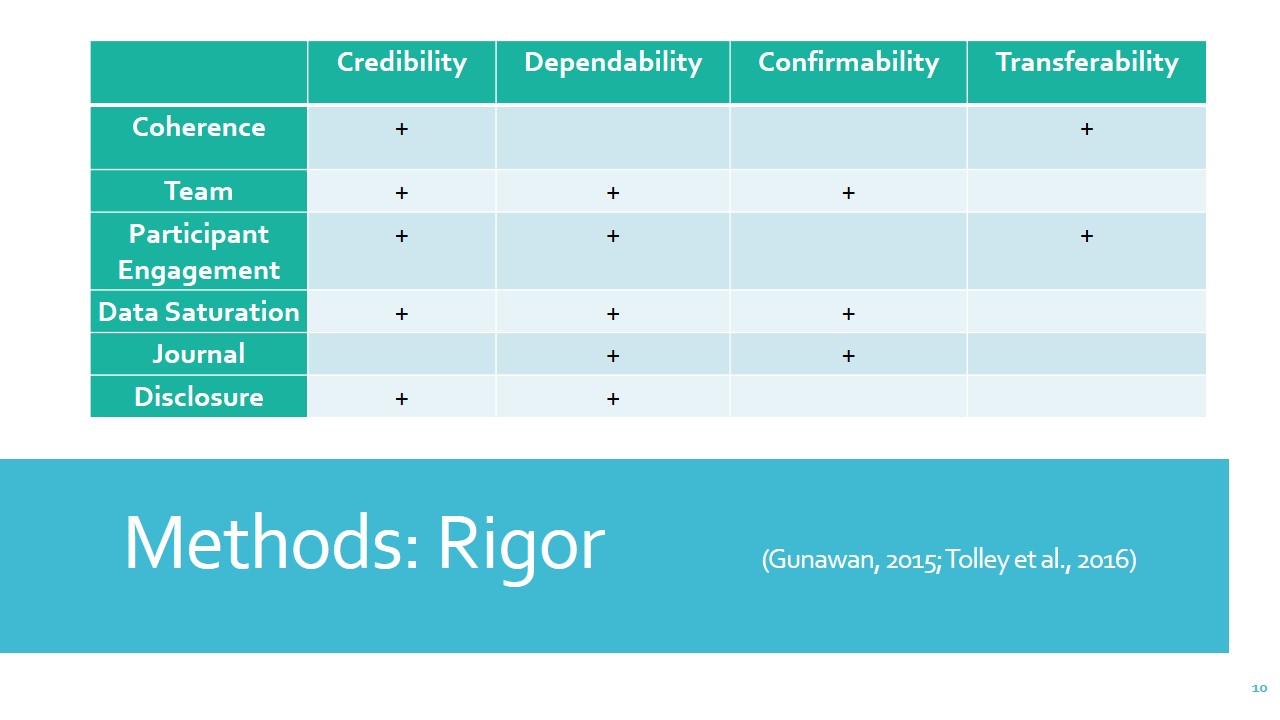
Limitations and Positionality
- Bias/Subjectivity:
- Risk factors: researcher positionality as a VM (from the Dominican Republic; 12 years of service in the US); human nature.
- Protections: rigor.
- Sample Specifics:
- Risks: small sample; recruitment bias.
- Protections: stratified sampling; avoiding generalizations.
- Self-Developed Interview Guide:
- Risk factors: untested/biases.
- Protections: testing (also helps with sensitivity).
Indeed, it is reasonable to consider limitations, including positionality. Positionality is one of the bias risks in this study since I am a Latino VM myself. However, since bias is common for research, the presented rigor precautions (especially teams, participant engagement, and reflective journal) are a reasonable solution to the issue. Furthermore, since the sample is rather small and can be subject to recruitment bias because VMs with especially bad experiences might not be willing to participate, it is a good idea to avoid generalizing the results. Finally, since the data collection tool will be made for the project, it will not be well-established, but it is planned to test it with a couple of migrants or veterans to make sure that it can gather the required information and that it is not insensitive.
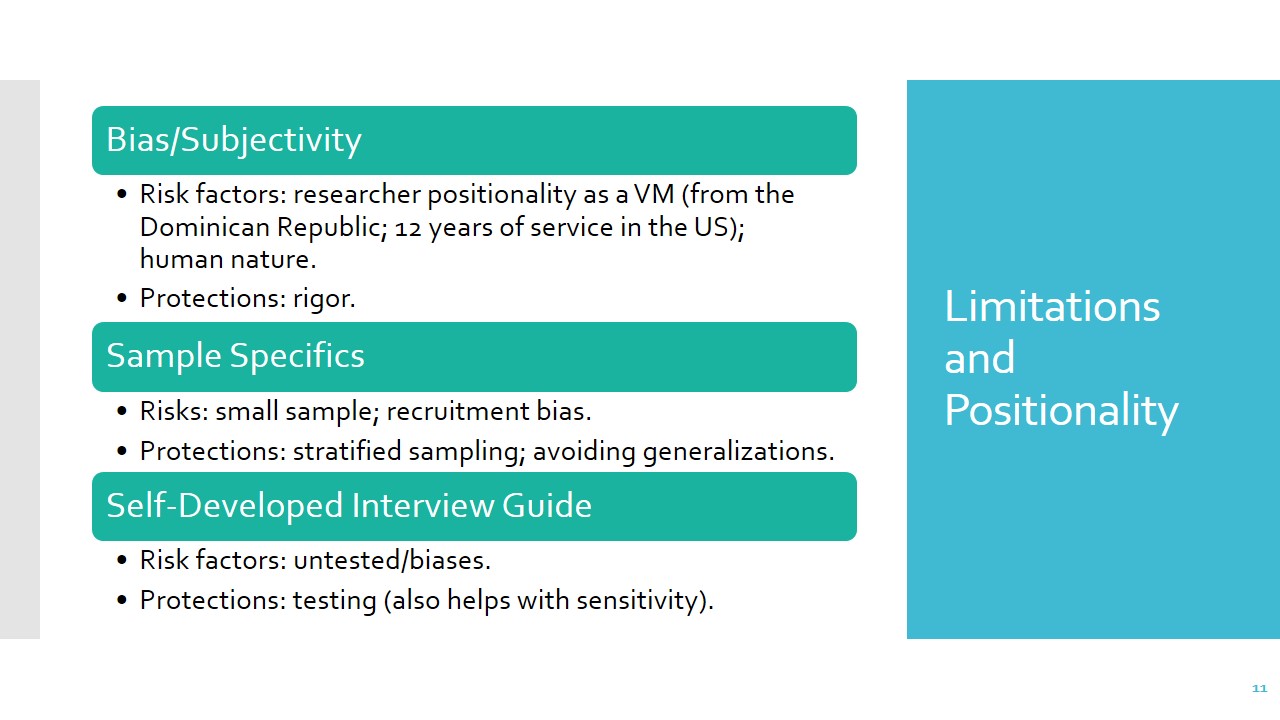
Human Subjects and Ethics
- Risks: discomfort (mitigated: example questions; referral).
- Ethics-ensuring mechanisms:
- Voluntary participation (plain flyers, no coercion).
- Informed consent (information about study, rights, protections). Example sentences below.
- Confidentiality (no identifying data, safeguards for protection).
In connection to sensitivity issues, it should be noted that distress is the primary risk of the project. The University of Hawaii guidelines will be used to ensure the project’s ethics. To mitigate the risks, the participants will be offered a counseling referral if they exhibit stress. However, the project will mostly focus on preventative measures. First, it will be important to make participation voluntary, which will be achieved with plain flyers and informed consent. Indeed, informed consent is the second requirement; it will provide all the details about the project (see the screenshot), including example interview questions, which will minimize distress risks for the participants. In addition, the participants’ data will be protected with the help of locked drawers and computer passwords; access to them will be restricted. This way, the participants will be safe, and the IRB of the University is likely to approve the project.
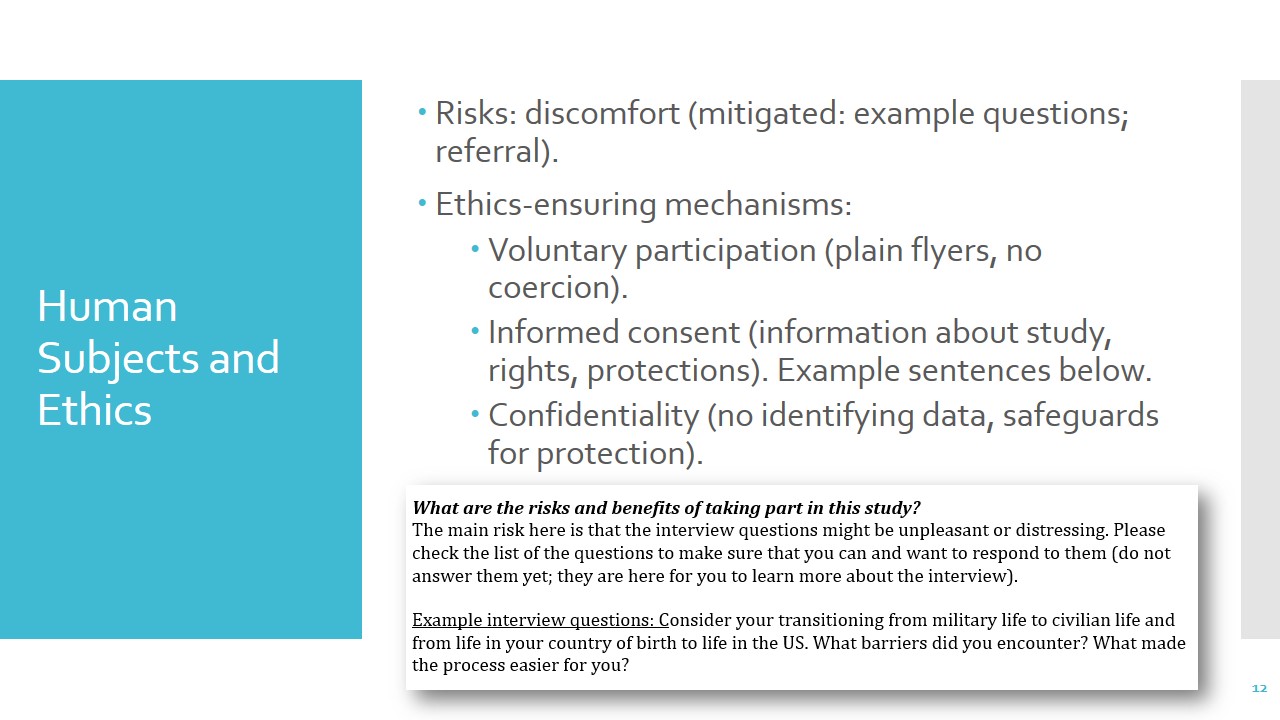
Expected Findings and Dissemination
- Findings:
- MCT/MT posing challenges and interacting (DVA, 2018 ; OSCE, 2018).
- Facilitators: culture, skills, social networks (Blackburn, 2016; Hachey et al., 2016; OSCE, 2018).
- More research needed.
- Dissemination Plan:
- Important for social work.
- Participants.
- Journals (e.g., Journal of Veterans Studies).
Based on the existing literature, it is anticipated that the findings will involve some information about factors that affect Latino VMs, as well as VMs, veterans, and migrants in general. This information will help to develop and deliver social services to the named populations, although with a small sample of 10 people, I do not hope that I will research the topic exhaustively; more research will be needed. Given the width of the research gap, it is also reasonable to disseminate the findings; I plan to use specialized journals for that purpose.
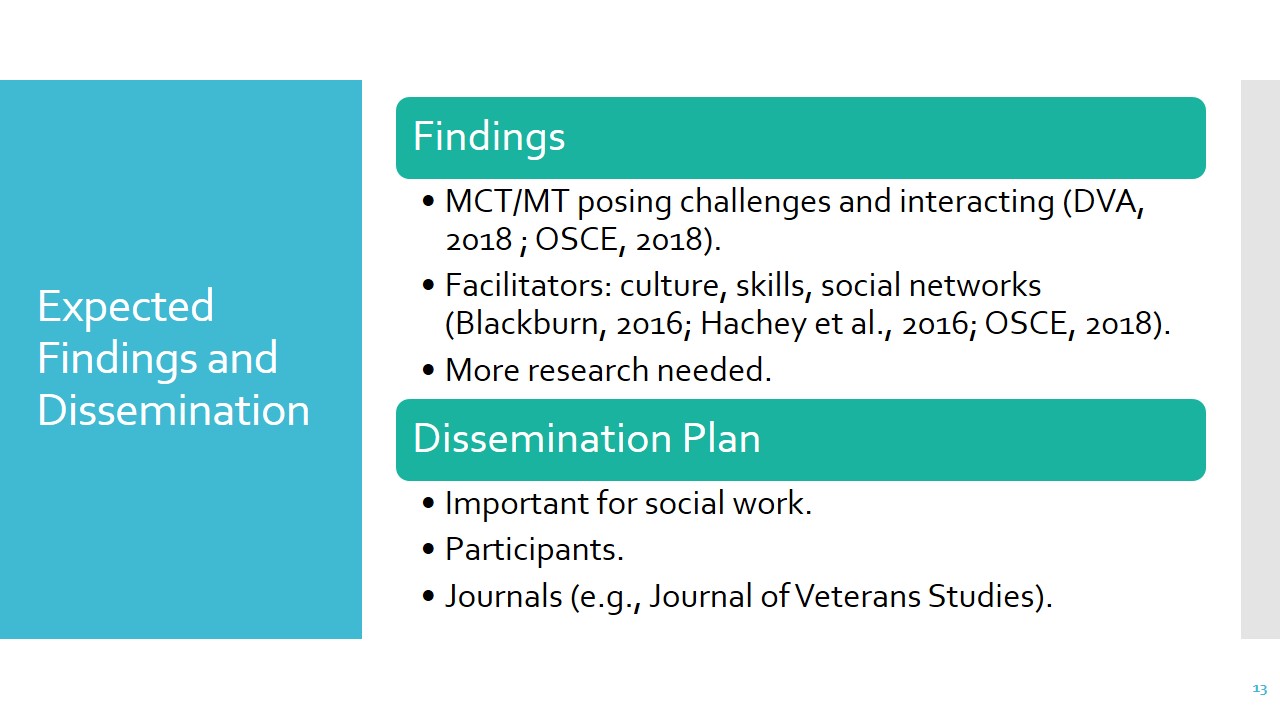
References
Atuel, H. R., Hollander, A., & Castro, C. A. (2018). Racial and ethnic minority service members. In E. Weiss & C. Castro (Eds.), American military life in the 21st century (Vol. 1, pp. 41-53). Santa Barbara, CA: ABC-CLIO.
Blackburn, D. (2016). Transitioning from military to civilian life: Examining the final step in a military career. Canadian Military Journal, 16(4), 53-61.
Gray, J. R., Grove, S. K., & Sutherland, S. (2016). Burns and Grove’s The practice of nursing research-e-book: Appraisal, synthesis, and generation of evidence (8th ed.). Philadelphia, PA: Elsevier Health Sciences.
Gunawan, J. (2015). Ensuring trustworthiness in qualitative research. Belitung Nursing Journal, 1(1), 10-11. Web.
Hachey, K. K., Sudom, K., Sweet, J., MacLean, M. B., & VanTil, L. D. (2016). Transitioning from military to civilian life: The role of mastery and social support. Journal of Military, Veteran and Family Health, 2(1), 9-18.
Horyniak, D., Bojorquez, I., Armenta, R., & Davidson, P. (2017). Deportation of non-citizen military veterans: A critical analysis of implications for the right to health. Global Public Health, 13(10), 1369-1381. Web.
Kelly, D. R. (2016). Applying acculturation theory and power elite theory on a social problem: Political underrepresentation of the Hispanic population in Texas. Hispanic Journal of Behavioral Sciences, 38(2), 155-165.
Leal, D. L., & Teigen, J. M. (2018). Military service and political participation in the United States: Institutional experience and the vote. Electoral Studies, 53, 99-110.
Hachey, K. K., Sudom, K., Sweet, J., MacLean, M. B., & VanTil, L. D. (2016). Transitioning from military to civilian life: The role of mastery and social support. Journal of Military, Veteran and Family Health, 2(1), 9-18.
Horyniak, D., Bojorquez, I., Armenta, R., & Davidson, P. (2017). Deportation of non-citizen military veterans: A critical analysis of implications for the right to health. Global Public Health, 13(10), 1369-1381. Web.
Kelly, D. R. (2016). Applying acculturation theory and power elite theory on a social problem: Political underrepresentation of the Hispanic population in Texas. Hispanic Journal of Behavioral Sciences, 38(2), 155-165.
Leal, D. L., & Teigen, J. M. (2018). Military service and political participation in the United States: Institutional experience and the vote. Electoral Studies, 53, 99-110.
Total available active military manpower by country. (2019). Web.
US Department of Veterans Affairs. (2018). The military to civilian transition 2018. Web.
US Department of Veterans Affairs. (n.d.). Veteran population. Web.
Wong, M. J. (2017). Culture-bound syndromes: Racial/ethnic differences in the experience and expression of ataques de nervios. Web.